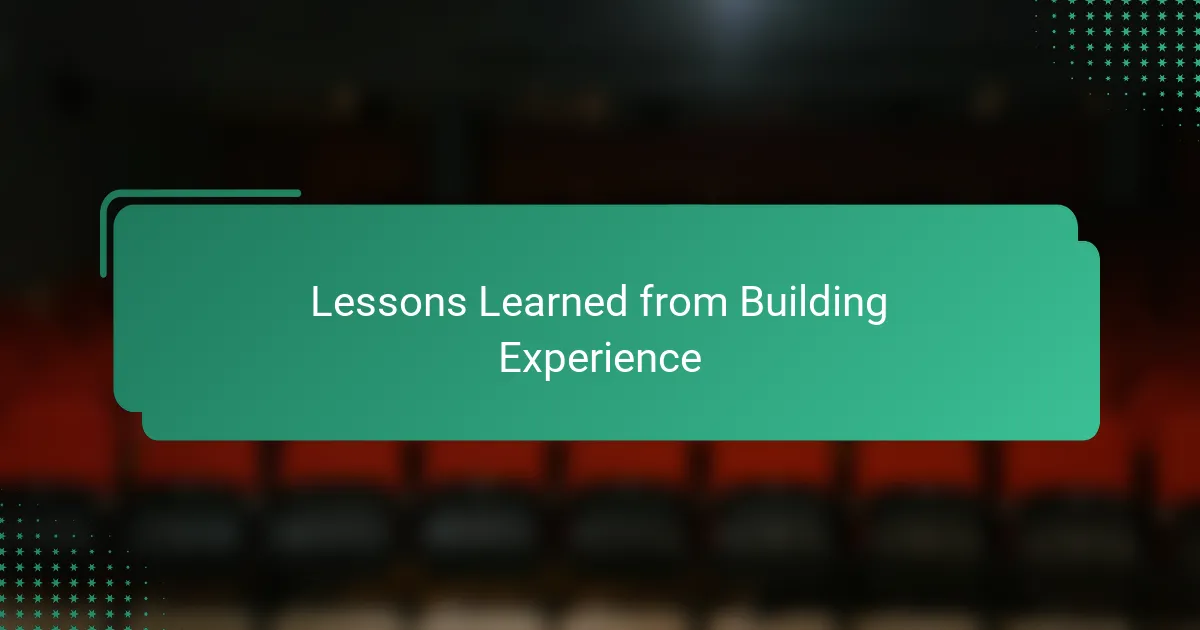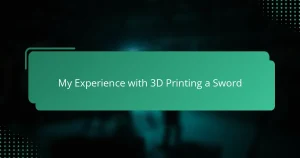Key takeaways
- Building science fiction props, like lightsabers, combines creativity with technology and serves as a bridge between fantasy and reality.
- The process involves careful selection of materials and gradual step-by-step construction, requiring patience and attention to detail.
- Challenges, such as managing heat and balancing durability with weight, foster adaptability and creative problem-solving.
- Celebrating small victories throughout the building process helps maintain motivation and enhances the overall experience.

Introduction to Science Fiction Props
Science fiction props have always fascinated me because they bring imaginative worlds to life in tangible ways. I often wonder, what is it about these objects that makes them so captivating? Maybe it’s the blend of creativity and technology, or the way they allow fans to step into stories they’ve loved.
From the sleek designs of futuristic gadgets to the rugged look of worn space gear, each prop tells its own story beyond the screen. When I first held a replica blaster, I felt a connection to the characters and worlds I admired growing up. It’s more than just an object; it’s a bridge between fantasy and reality.
I’ve learned that building or collecting these props isn’t just about having something cool on a shelf. It’s about the passion and craftsmanship involved, and the thrill of recreating something once thought impossible outside of fiction. Have you ever tried to bring a piece of your favorite sci-fi universe into your own life? That challenge is what makes the entire journey so rewarding.

Understanding Real Lightsabers
When I first started thinking about what a “real” lightsaber could be, I quickly realized the challenge lies in translating a fictional energy sword into physical reality. How could something so iconic, with a blade of pure light and limitless power, exist beyond movies? This question drove me to dig deeper into both the science and the myth behind lightsabers.
At its core, a real lightsaber isn’t just about flashing LEDs or sound effects. It’s about understanding the principles—like plasma, magnetic fields, or futuristic energy sources—that might one day make a compact, handheld energy blade possible. I found this blend of cutting-edge science and imaginative engineering absolutely thrilling, even if the perfect version remains out of reach for now.
Throughout my journey, I often wondered: what technology could truly mimic the seamless extension and retraction of a lightsaber’s blade? Though I haven’t cracked the code yet, exploring concepts like high-energy plasma containment and lightweight power cells opened my eyes to how close and yet how far we are from this sci-fi dream turning into reality.

Materials Required for Lightsaber Building
Gathering the right materials was my first real test in this venture. I started with something simple—the aluminum tubing for the hilt—because it felt sturdy yet lightweight, just like I imagined a real lightsaber handle should be. But then, I realized I needed more: LEDs for the blade’s glow, a diffuser to spread light evenly, and small circuit boards that could control the lights and sounds.
I remember staring at piles of wires and components, wondering if I bit off more than I could chew. Did I really understand how these tiny parts would come together to mimic such an iconic weapon? At that point, sourcing a reliable power supply seemed crucial—something compact but powerful enough to make that blade shine bright without overheating.
What surprised me most was how varied the materials turned out to be. From acrylic rods to form the blade to soundboards designed for cosplay lightsabers, each piece required its own little research and experimentation. The mixture of basic hardware store finds and specialized electronic parts made this project feel like a real blend of craftsmanship and tech wizardry.

Step by Step Construction Process
Breaking down the construction into clear, manageable steps was essential for me. I began by assembling the hilt, carefully shaping and sanding the aluminum tube until it felt comfortable in my hand—almost like crafting a sword for a Jedi. Have you ever noticed how the smallest details, like grip texture or button placement, make all the difference in bringing something to life?
Next came wiring the electronics, which was both thrilling and nerve-wracking. Connecting LEDs and soundboards inside such a compact space felt like piecing together a high-tech puzzle. I remember the moment when the blade lit up and the first hum sounded—I felt a rush of accomplishment that made all the fumbling worthwhile.
Finally, attaching the acrylic blade and diffuser was surprisingly satisfying, as it transformed the project from a bunch of parts to a glowing, almost magical prop. Watching the light spread evenly down the blade convinced me that patience and precision truly pay off. Have you ever experienced that instant when everything just clicks, and your creation seems to leap off the bench into reality? That feeling made every step unforgettable.

Challenges Faced During Building
One of the biggest hurdles I faced was managing heat. Those bright LEDs and the compact circuitry generated more warmth than I anticipated, making me worry about safety and component longevity. Have you ever noticed how something that looks simple can suddenly get complicated just because of tiny, overlooked factors like heat dissipation?
Another challenge was achieving the perfect balance between durability and lightweight design. I found myself constantly juggling between sturdy materials that could withstand handling and keeping the saber easy enough to wield comfortably. It felt like a delicate dance—too heavy, and it loses the magic; too fragile, and it’s just a display piece.
Wiring the electronics inside the narrow hilt was, without a doubt, a test of patience. There were moments when wires tangled or connections failed, and I questioned if all the effort was worth it. But pushing through those frustrating hours made the moment the lightsaber finally powered on even sweeter—don’t you think the toughest challenges often lead to the most rewarding victories?

Testing and Final Adjustments
Testing the lightsaber for the first time was a mix of excitement and anxiety. Would the blade glow consistently? Would the sound effects sync up perfectly? I vividly remember holding it up, heart pounding, as the LEDs flickered to life—only to reveal a slight unevenness in the light distribution that I hadn’t noticed before.
That moment pushed me into making the final adjustments, tweaking the diffuser’s position and re-soldering a few connections. It felt like tuning a delicate instrument; even the smallest shift could improve the overall effect dramatically. Have you ever caught yourself obsessing over tiny details that suddenly make everything look and feel just right? That was exactly me at this stage.
After a few rounds of trial and error, I finally achieved a blade glow that was smooth and vibrant, with sound effects that matched each motion seamlessly. It was deeply satisfying to see all the elements working in harmony—it turns out that perfection really is in the details. Testing wasn’t just about function; it was about capturing the magic I’d imagined from the start.

Lessons Learned from Building Experience
One lesson that stood out for me was the importance of patience. There were moments when it felt like the project would never come together—the wiring got tangled, LEDs flickered unpredictably, and heat issues seemed impossible to solve. But stepping back, taking a breath, and tackling each problem methodically made all the difference. Have you ever worked on something so complex that frustration threatened to take over? Learning to pause and approach challenges one piece at a time really saved the experience from turning overwhelming.
I also realized how crucial adaptability is when building something so intricate. Sometimes materials didn’t perform as expected, or parts needed creative modifications to fit perfectly. At one point, I had to rethink the diffuser entirely because the light spread was patchy. It was disappointing, sure, but it pushed me to experiment and find a better solution. Isn’t it interesting how setbacks can spark unexpected creativity and deeper learning? Those moments taught me to embrace flexibility instead of sticking rigidly to the original plan.
Lastly, I learned that celebrating small victories keeps motivation high. Each successful solder, every little improvement in the light’s glow, felt like a step closer to bringing a fantasy to life. That first moment the hilt felt solid and the blade lit up was unforgettable—it made all the late nights worth it. If you’ve ever built something complex, you know how crucial it is to recognize progress along the way. It’s those wins that fuel the passion to see the project through to the end.


